Epic 2023 Tuesday conference notes
I’m back for another day of EPIC. My notes for Monday’s sessions are here Notes for Wednesday are here
Friction in Sustainability Transitions: Lessons From Organizations and Institutions
Professor of Management & Organizations, Kellogg School of Management at Northwestern University
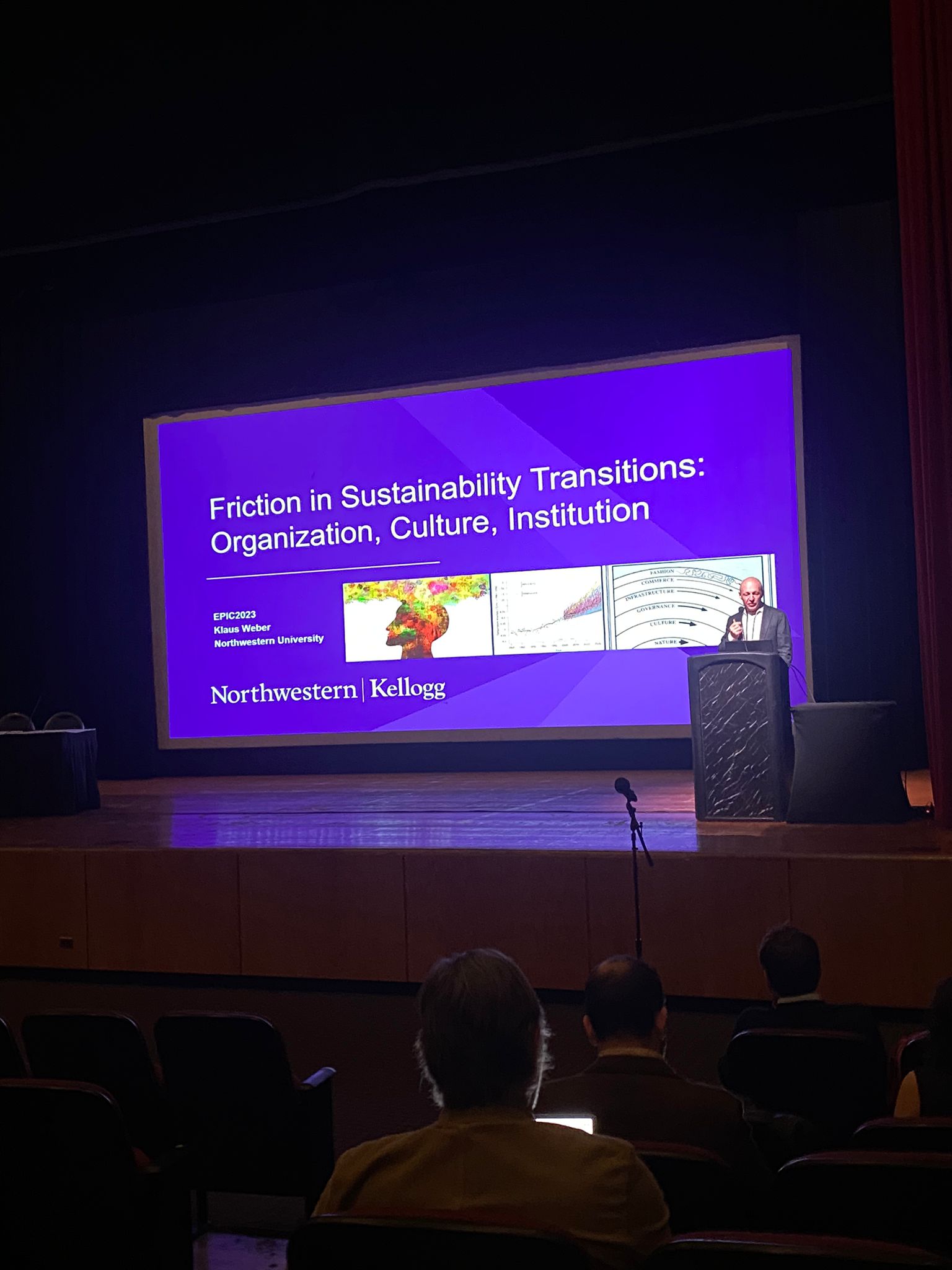
The temporal dynamic of how we get to a better world that’s more sustainable, and the central role that organizations play in facilitating that path forward.
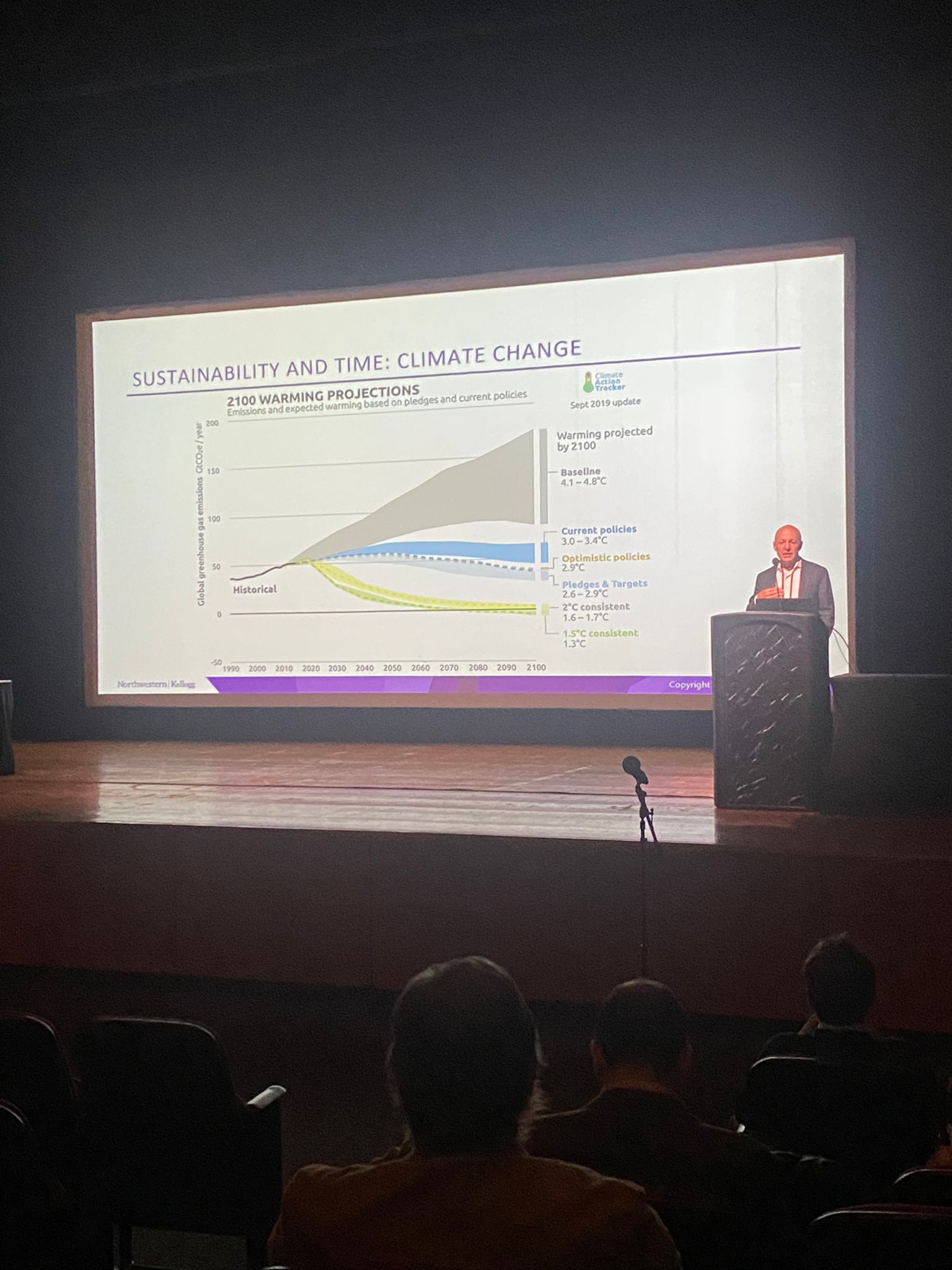
Global warming chart - two things to take away from it. 1 is that it is dire. what we take today others in the future will have to pay for. 2 is that the kink in the 1.5 degree line implies a sharp shift and transition from the current trajectory. So how can we make those transitions in a short timeframe?
when we think of sustainability we cannot stop at climate, circularity, and clean water. we have to include social equity, peace, education, etc - in a holistic way. “an overall way to change the way we run our economy to get to a new equilibrium”
they are all interconnected. Using climate as an example because there is good data for it
There’s a body of work that looks at relatively short time shifts
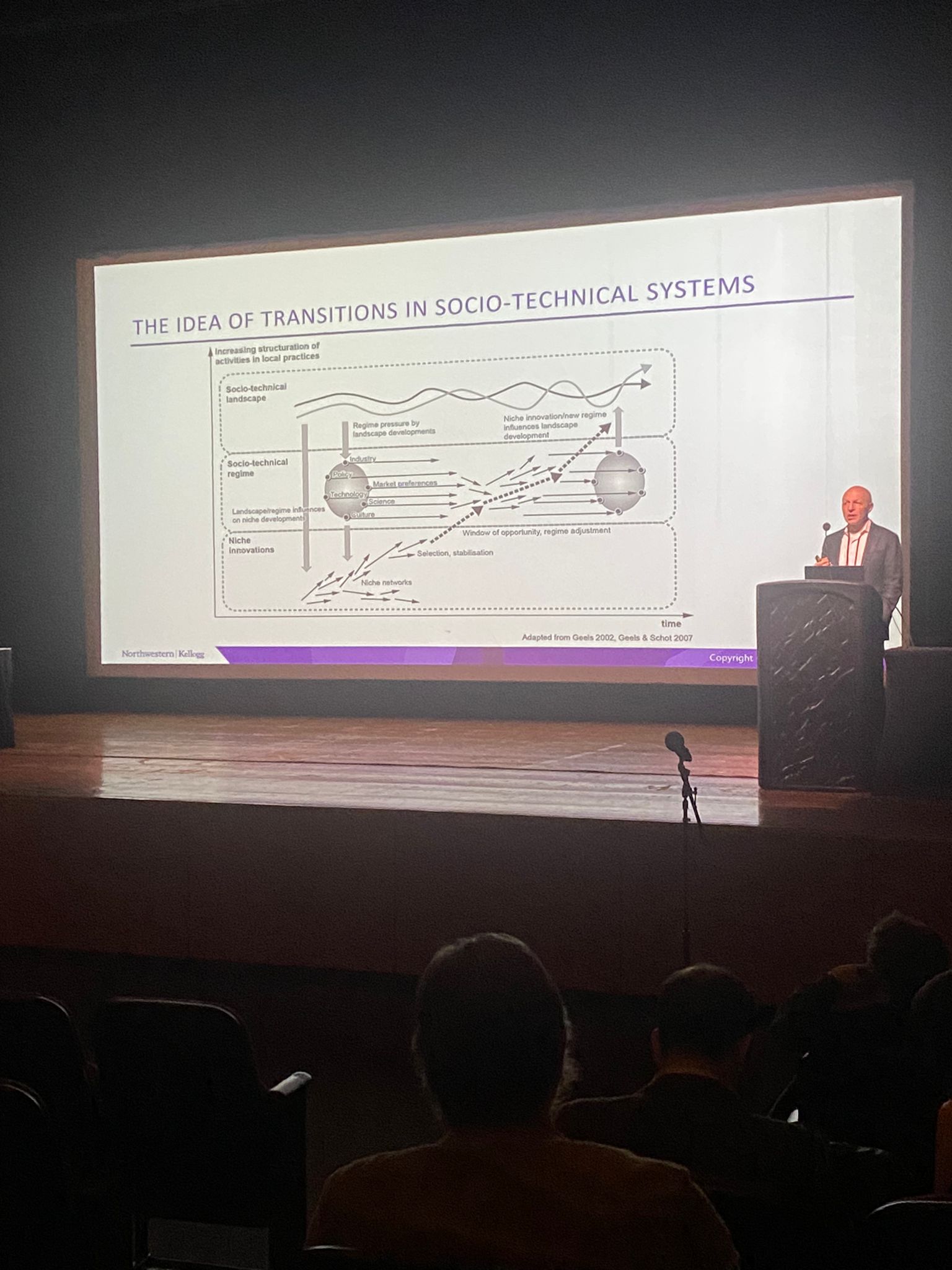
scaling doesn’t happen automatically, it happens when all those forces come together - this then leads to change being ingrained.
We typically think of this as an S shaped curve - lots of foundation building work initially, hit tipping point then rapid acceleration; then hits lock in point where you can’t go back.
This is the typical model for thinking about transitions, but in reality there’s friction during the process. what if it looks like these curves instead?

When this happens we blame friction. i.e. the logic of the S curve assumes that acceleration is automatic.
But empirical research shows that actually all these curves happen all the time. So why/how come/what explains these differences?
Main point: these differences happen from frictions between the different temporal/pace layers of an organization system.
“tension is the equivalent to friction in a static way”
The analogy of different ‘temporal strucutres’ in an org is like that of different pace layers of a building. The site is long-term, stuff inside the house turns over much quicker.
The different pace layers of energy transition:
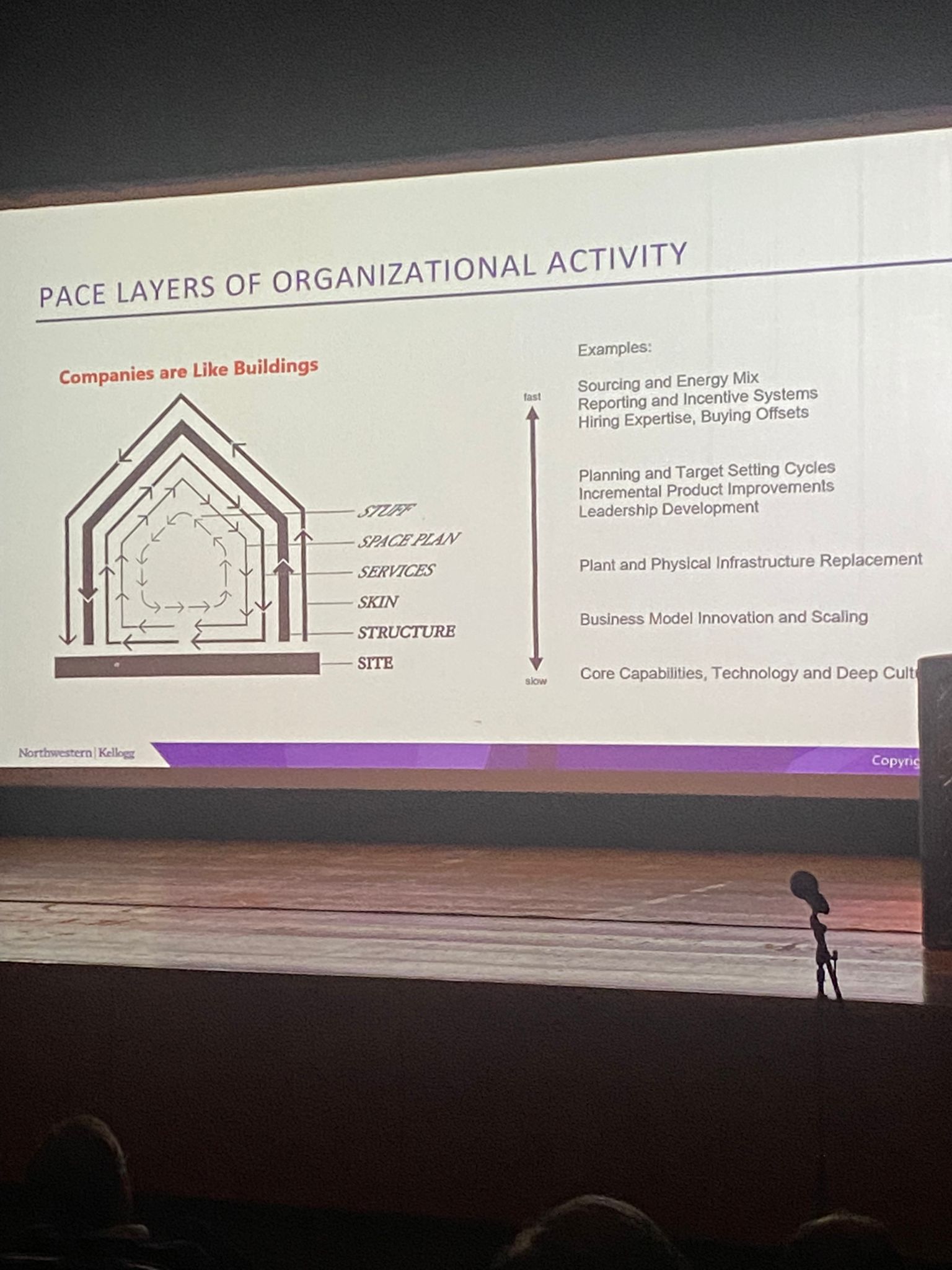
Normally we think fo organizations as a heirarchy. You can also think of organizations across three layers / faces: Activities, meaning and power:
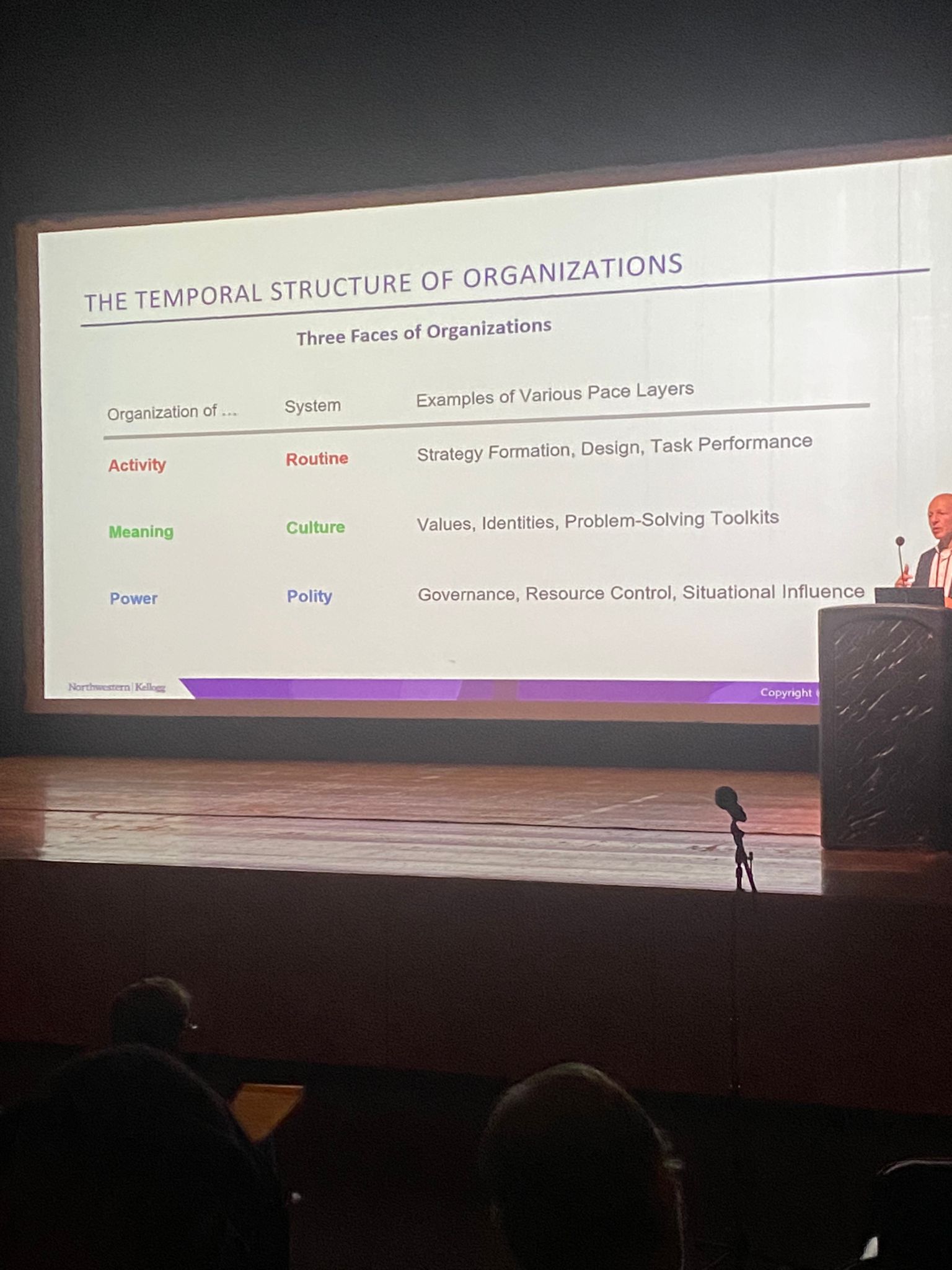
Focusing on the ‘culture’ face of it: there’s a tension between the urgency of issue and how long it takes to change culture.
Culture is layered too. think of culture not as one thing but a temporal structuree with many layers.
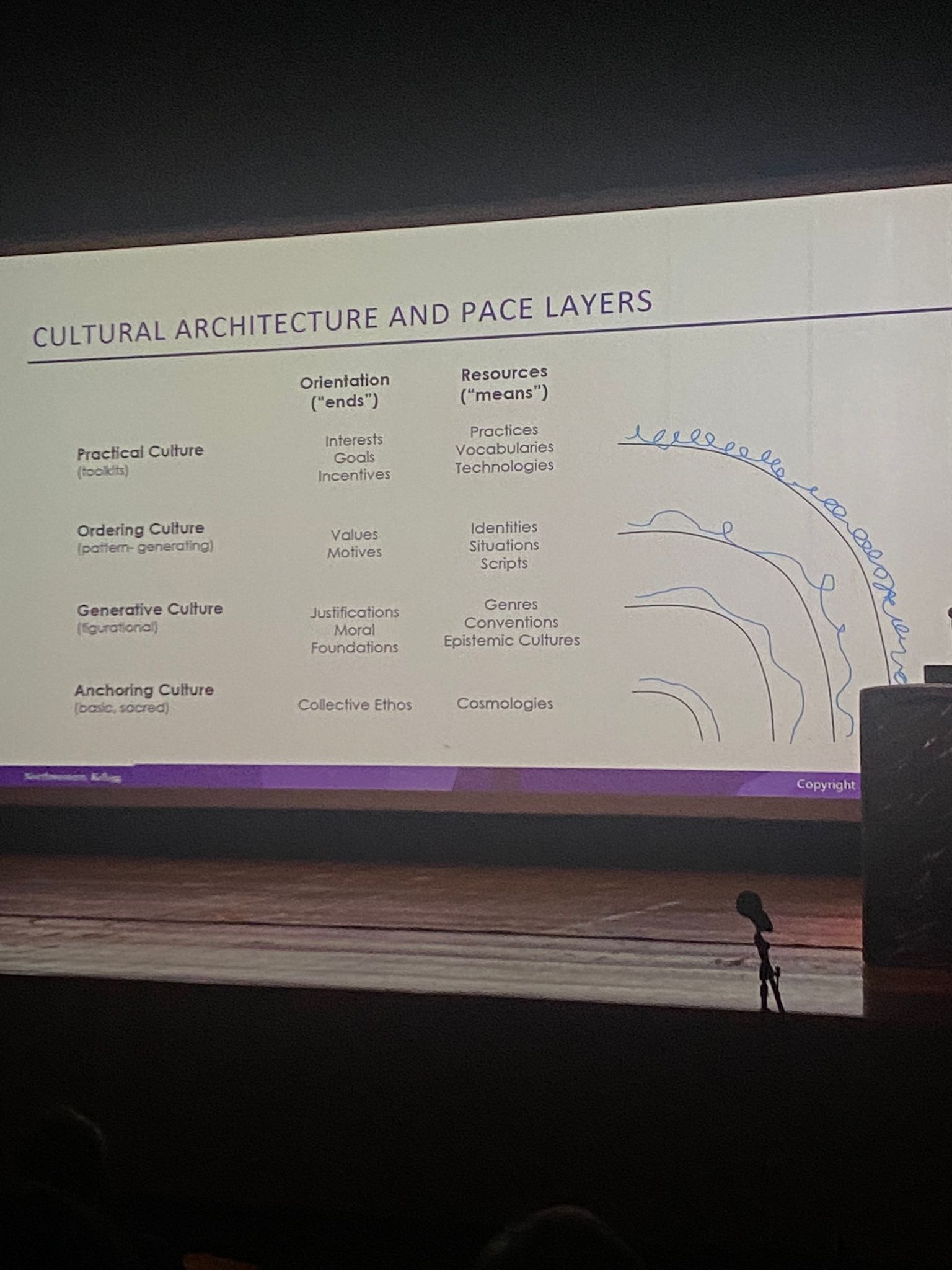
note: interesting that the different temporal layers i.e. fast->slow mirrors layering of explicit->implicit
What does sustainability culture look like? Sustainability often framed around initiatives and activities, and not as embedded culture.
“My take of it is that we have no concrete example of what it looks like” - i.e. no org has achieved it and therefore sustainablty is a proejction of a distant future.
This is important because imagination, visioning, futuring, etc is very different from ‘what we are doing now’ in terms of how we approach it. It’s also psychologially distant. 4 elements of psychological distance:
So Q is - what WOULD be an ideal sustainability culture look like?
Took semiotic approach in setting up opposition between sustainable vs unsustainable. translate that into different aspects:
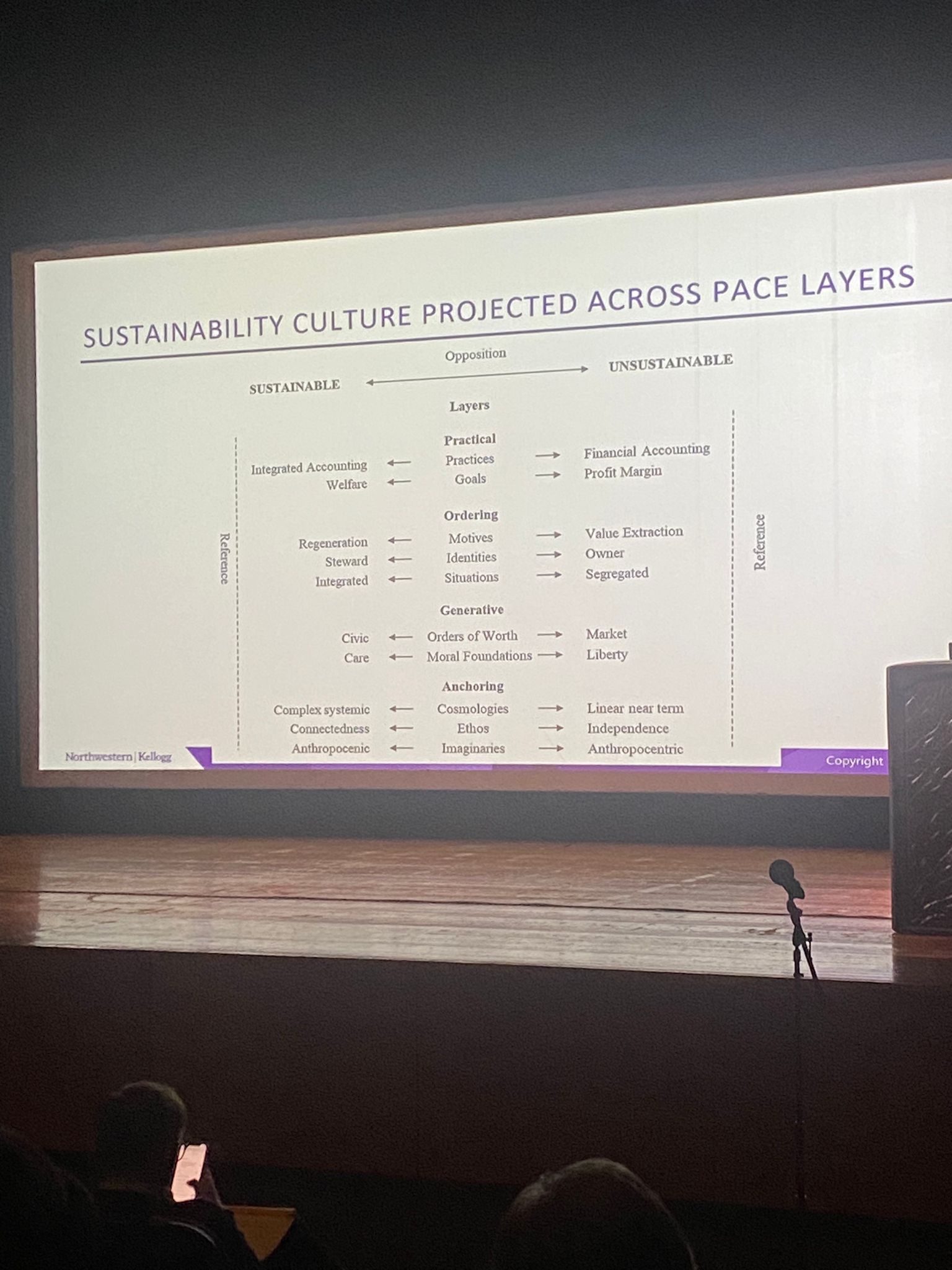
note: ok, but if we’re starting from present reality and thinking of the ideal in opposition to it, are we limiting our imagination? this feels like a ‘negative’/reactive approach to defining sustainability
Assuming the above frameworks/models, what are the srouces of friction?
- Friction from change ith dissonance between pace layers.
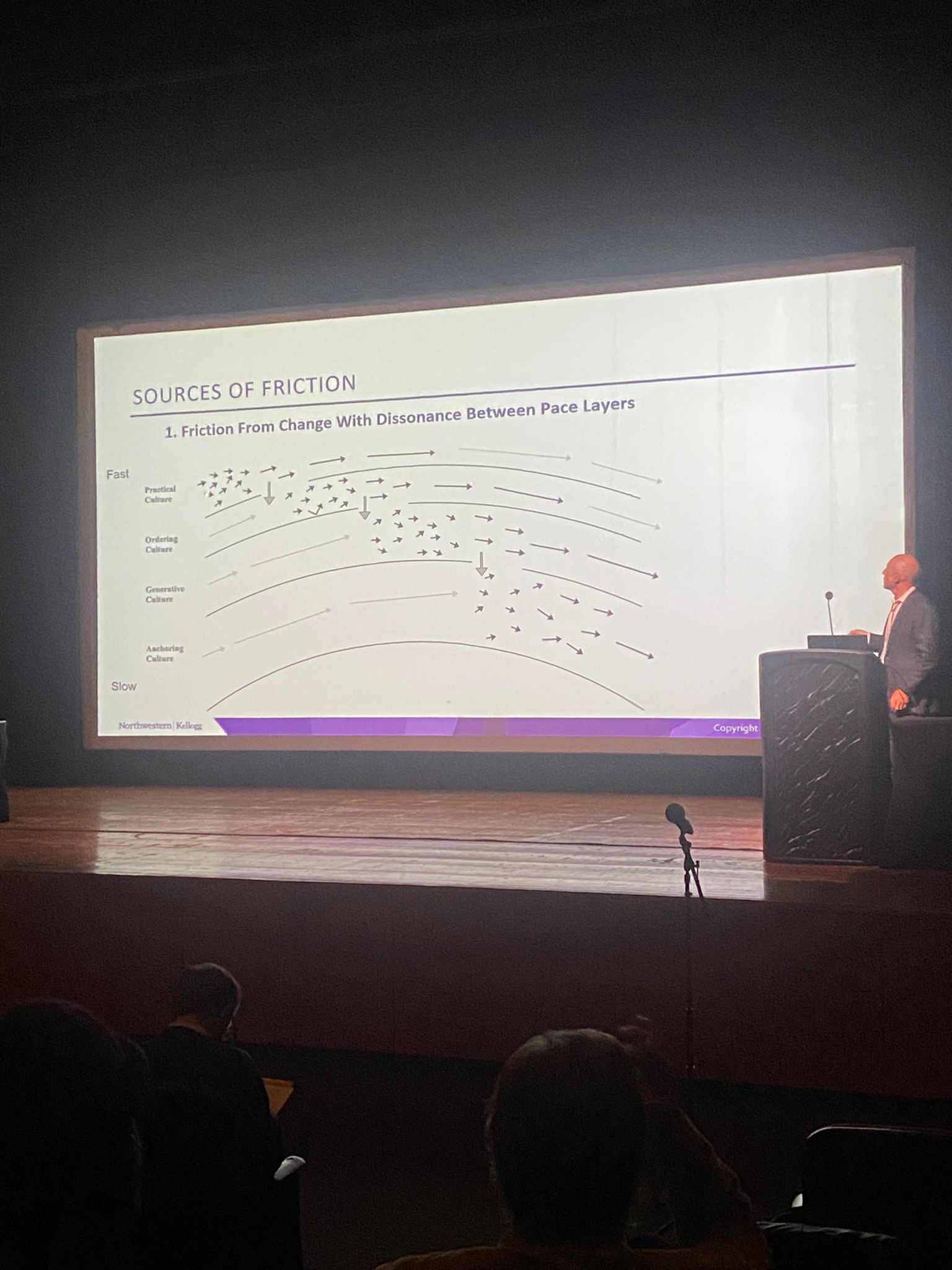
The reason why the changes happening at the faster layers are not translating into changes at slower layer is because of boundary friction: basically, culture is slow to change (but this chart goes some way to explain why)
If you want to ‘notice’ these frictions: look for Failed interaction rituals, conflict, resistance, polarization, reversals inaction and decoupling.
- Friction from Intervention with naive projection
i.e. unrealistic expectations. This happens because of psychological distance - long term projective ideal is more theorized, abstract, simple, etc. Details/breaking this down:

“Our imagination is based on ideologies, desired identities and principles”
side note: this point has implications for solutions journalism, future-based journalism, journalism that sparks imagination, etc and helps explain the tension between those and ‘traditional’ journalism.
Ethnogrpahic approaches to sustainability transformations can help - by ethnographic, mean simply very concrete, very grounded, very community-engaged approaches. i.e. bring realism back.
Common responses to reducing friction:
-
increase power - but problem of passive compliance and risk of countermobilization. the more you push for sustainability the more you make it a political issue
-
increase choice: (i.e. you dont have to do it / do it it this way; do it your own way) problem of scaling and questions of equity
Better response: embracing friction
-
pacing: timing intervention to watershed moments/fulcrum points/moments when the different cycles match up
-
recognition and stakeholder dialogue in design and implementation
Dynamics of Power and Agency
Friction as Sneaky Power (PechaKucha)
Ted McCarthy, Ethnographic Researcher (Presenter)
Sneaky power - not saying no, but using friction to say no
UXR work - find friction in people’s lives, then fixed it. but this ignores how friction is often created intentionally, to structure power
what makes htis power sneaking is that it’s often invisible, and therefore has plausible deniability
“desert kites” in middle east - used to funnel herd animals to slaughter. when you look at these ‘kites’ on the ground, they are short and not noticeable as barriers/structures.
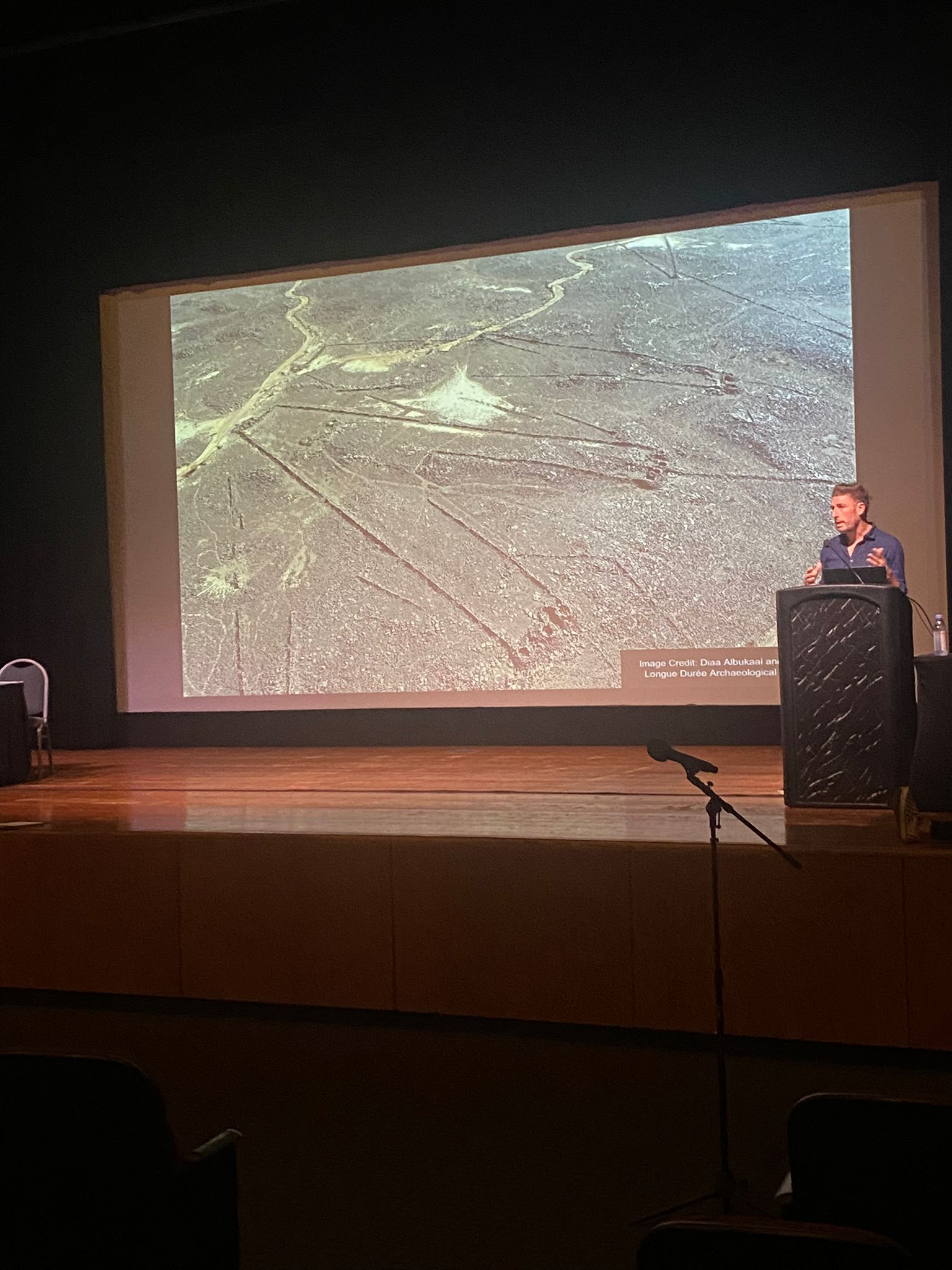
in world of tech - ‘dark patterns’ such as privacy or cancellation flows are such deliberately-constructed frictions
much harder to see is bureaucratic / people friction. shows up in bureaucratic requirements in immigration, abortion, etc
theory of violence - Johan Galtung - 3 types of violence: going to focus on systemic violence
The Sound of Friction: How to Do Things with Listening (Paper)
Michael Powell, Practica Group (Presenter)
Year-long ethnographic research into latino voters in texas. was in analysis when pandemic hit, and client commissioned follow up on non-voters re: govt pandemic response.
found that respondents cited previous interview as reason for change in their voting intentions, even though methodolgoy and intv avoided judgmental positions
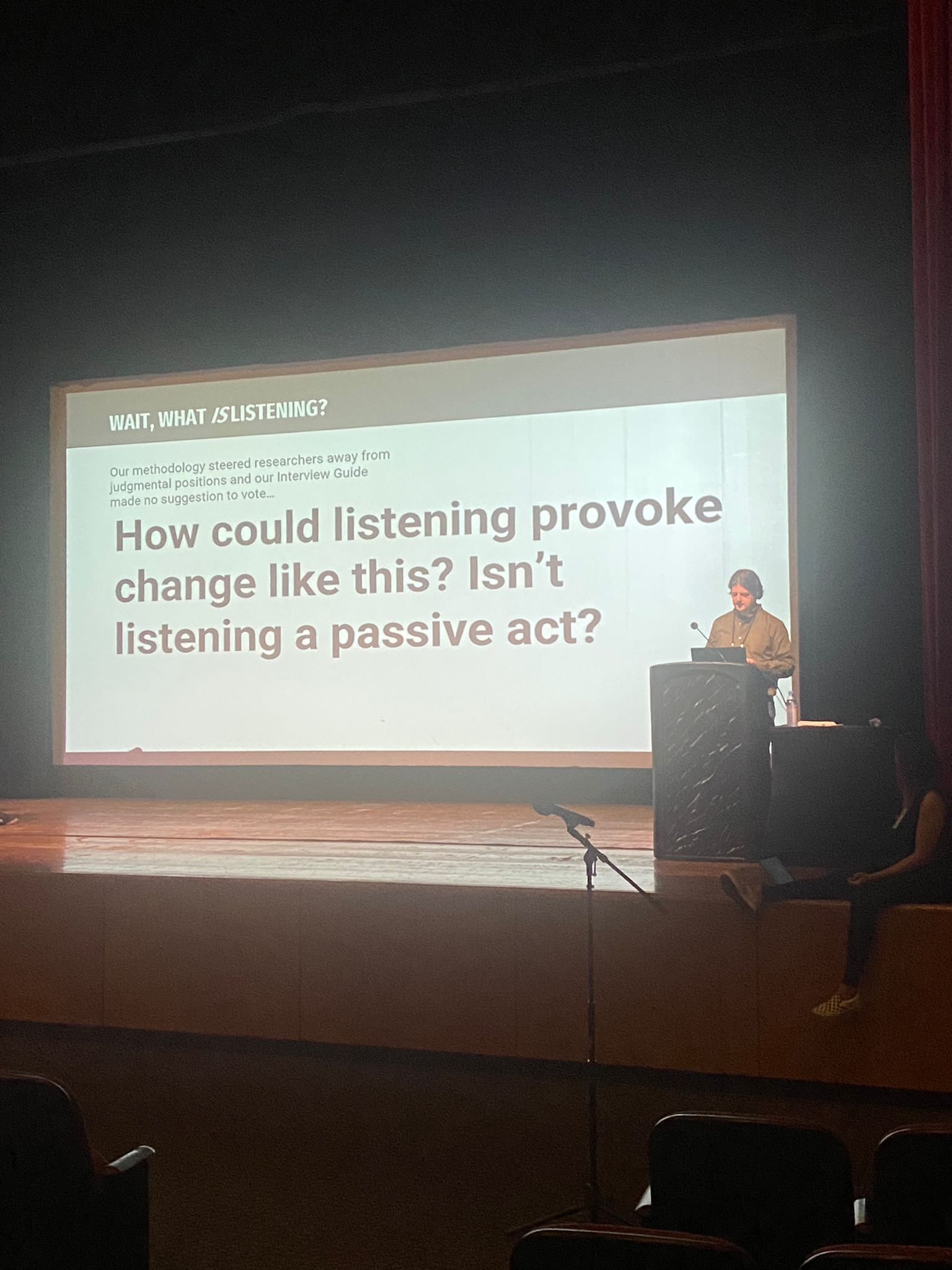
Ethnogrpahic listening is multi-dimensional process. ethnographers don’t listen ‘better’, they listen differently.
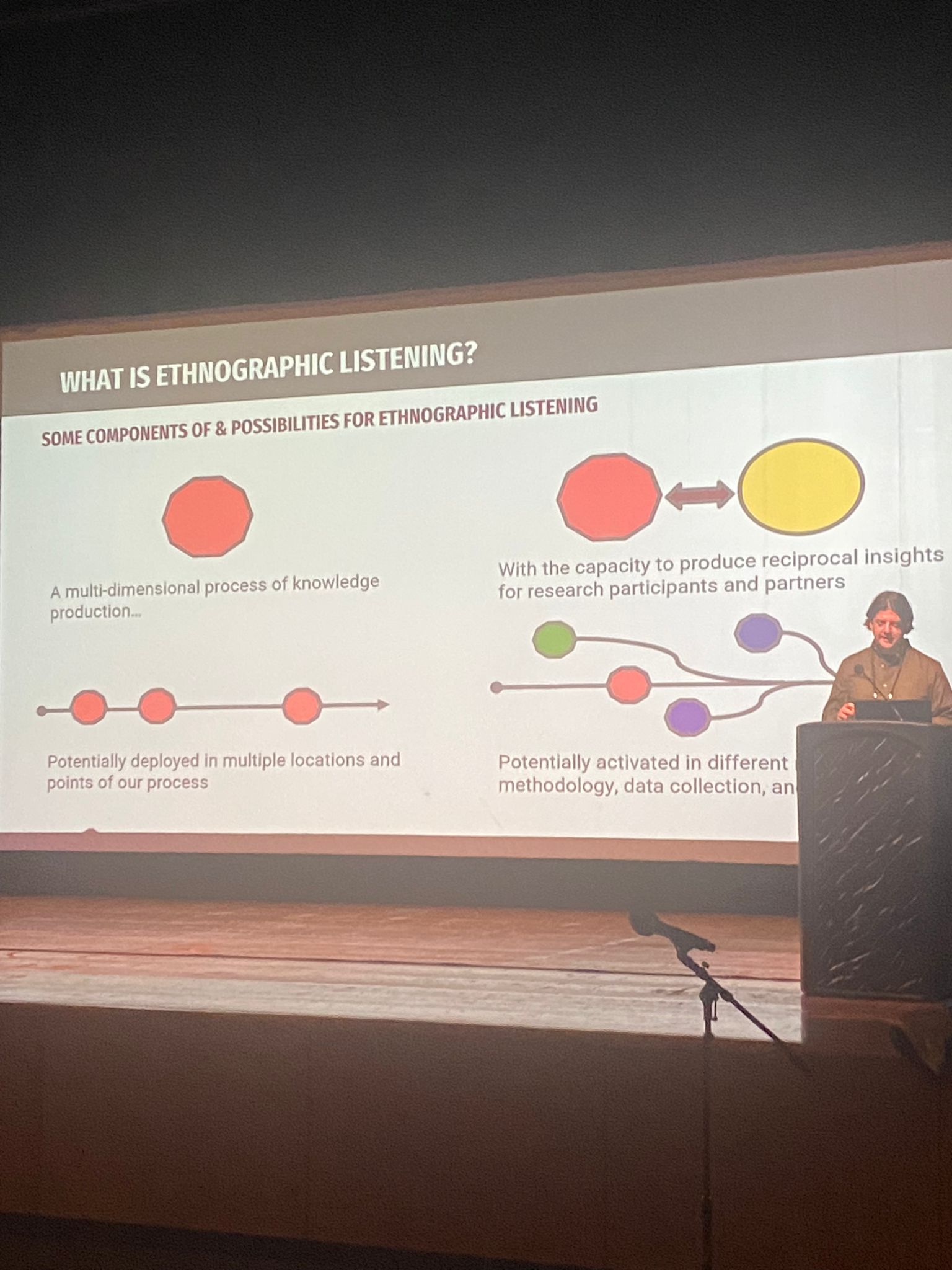
v interested in how ethnographic listening can prodcue connection/relationship that generateds reciprocal insights for research participantsa nd researchers.
Frictions: listening is a key skill, but rendered invisible in reporting to clients/others
instead of “how to listen better?”, ask: “What does listening do?”
- inspiring people
- generating discovery (personally & collectively)
- alignment
- attunement
Who else does things with listening? - artists i.e. pauline oliveros:

Mapping the practice of listening. attentiveness is just one aspect:
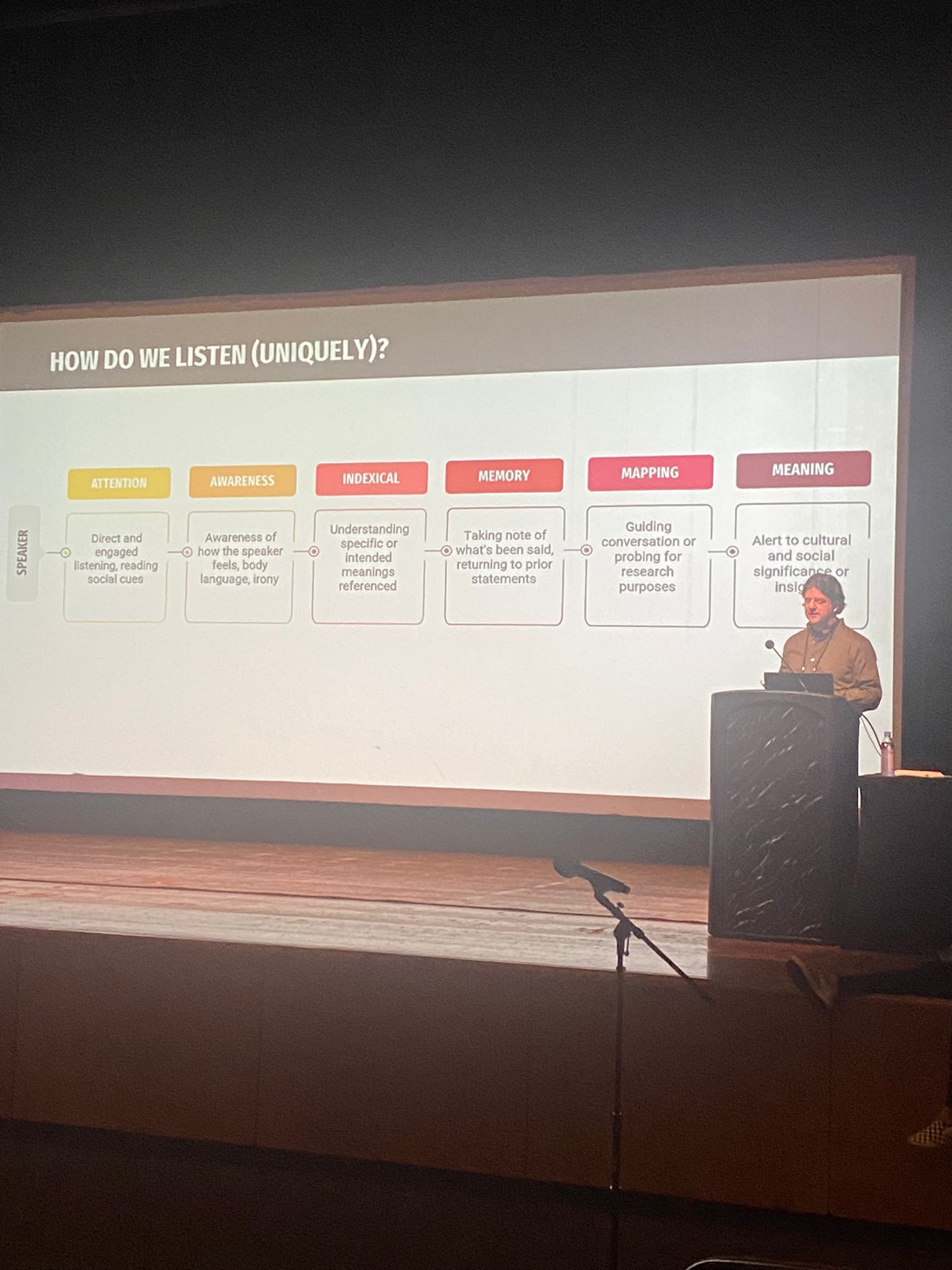
Where do we listen / when during the proejct process do we listen?
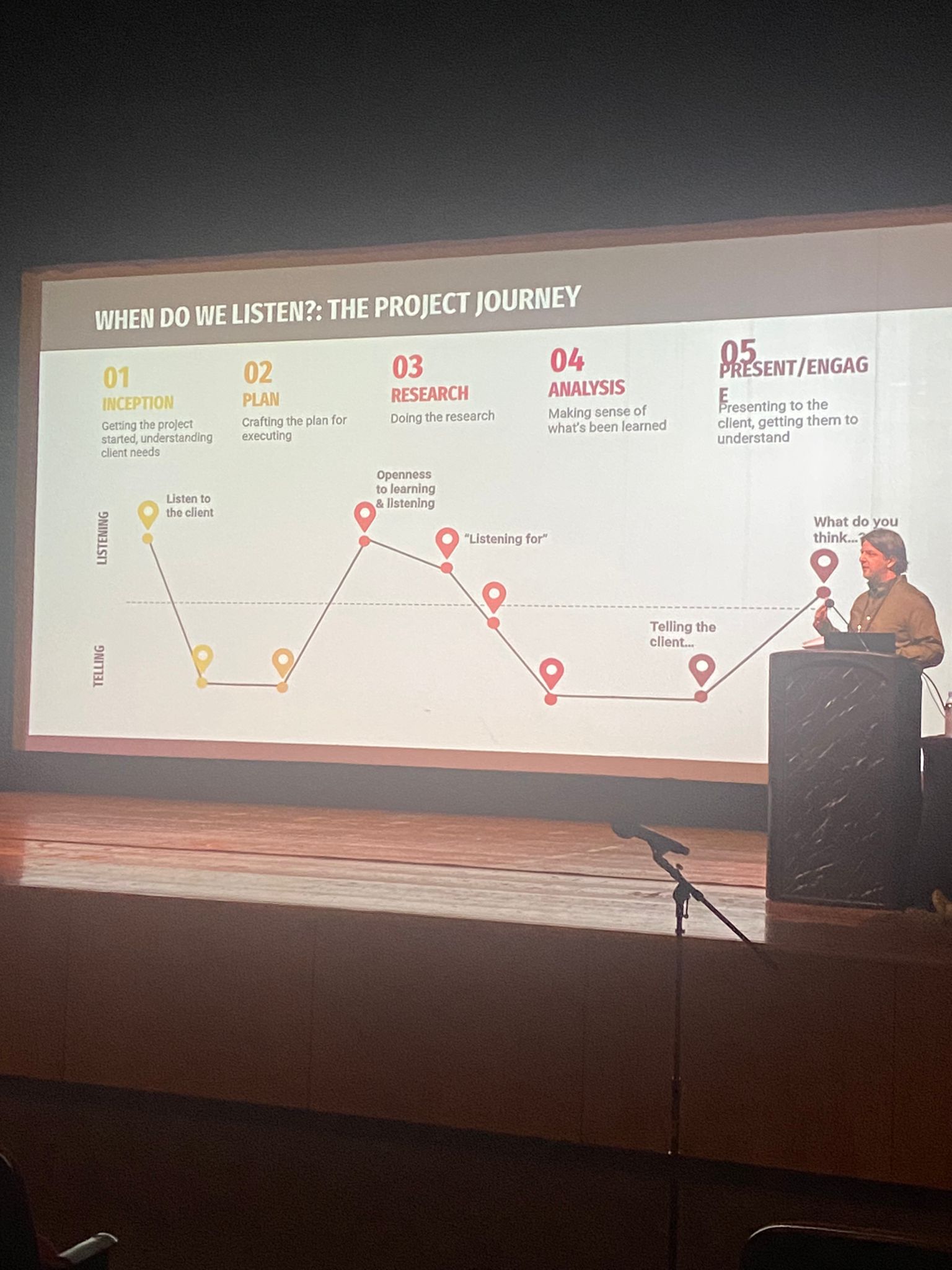
what if we have these listening methods and we can integrate it into all aspects of project process?
One example: community listeners - taking individual interviews and researchers who were doing individual listening, have a ‘community listener’ who functions as a dj to play clips; unrestricted reflection and discussion
how to do more with listening:
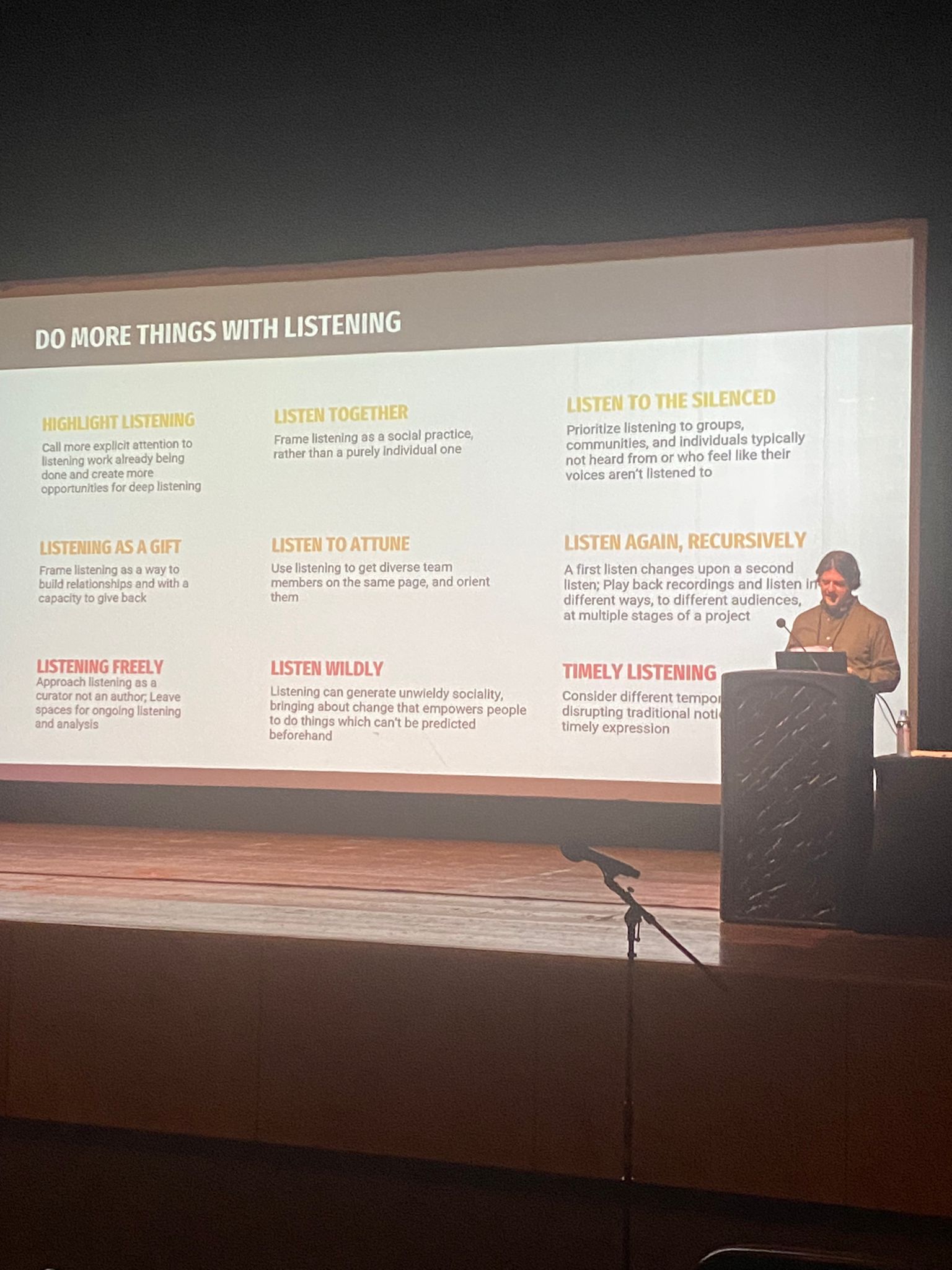
Government Forms as Friction: Identifying Opportunities for Innovation at the Intersection of Staff and Resident Needs (Paper)
Nadine Levin, San Francisco Digital Services (Presenter)
Forms take on lots of different sizes and shapes; i.e. fillable pdf, digital forms, paper
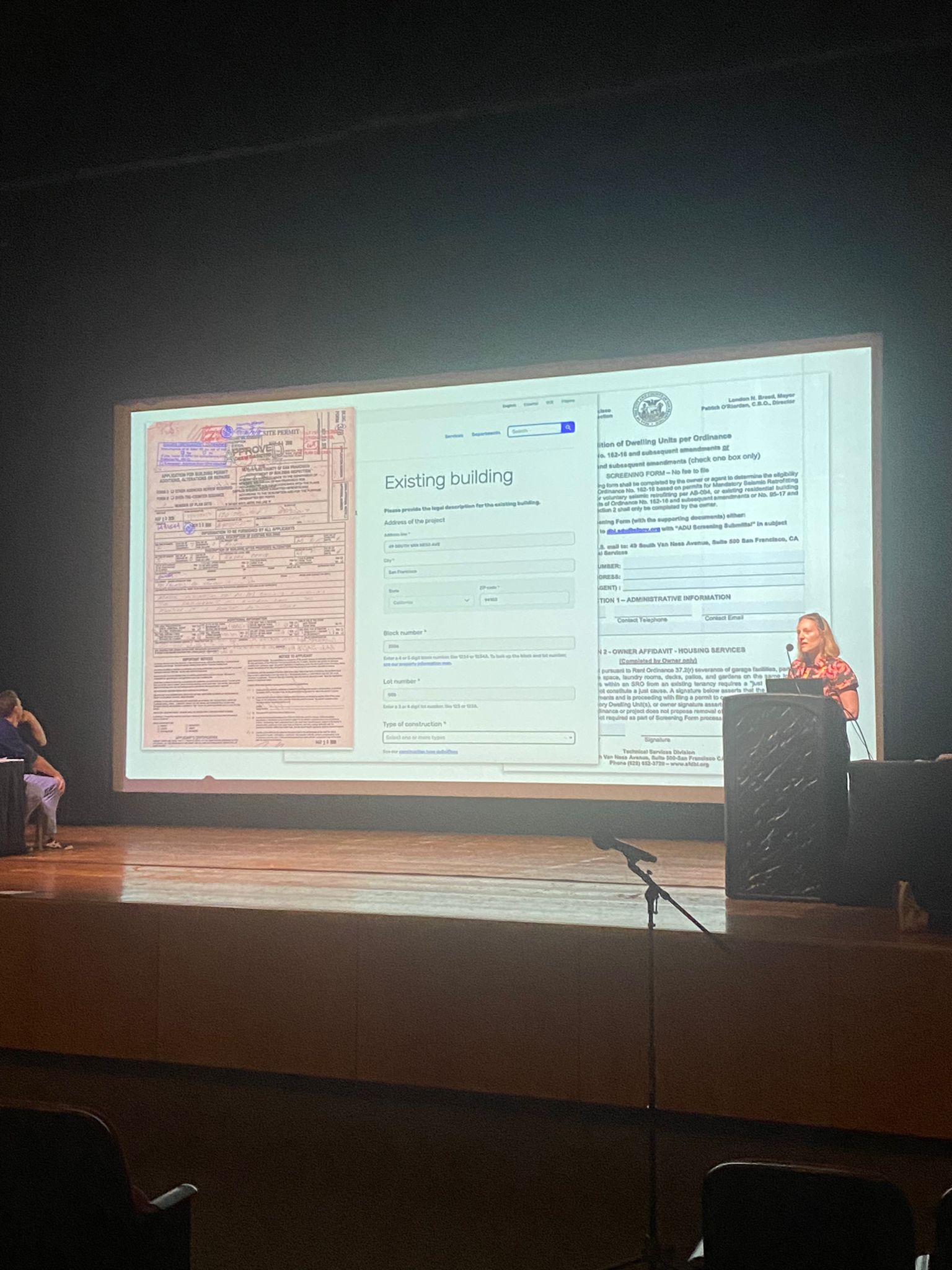
Forms seen (in ethnography) aa mundane and invisible.
What if we see forms as more than just textual documents? and instead as material objects - focus not on what they represent but what they do - how they move through organizations, embody values, and power, and constitute new lived realities. look at the active work of ‘forming forms’
Within a form, each question represents competing needs and goals. Forms are a nexus of different goals, needs, processes, and constraints for the delivery of government services.
Common/overarching question:
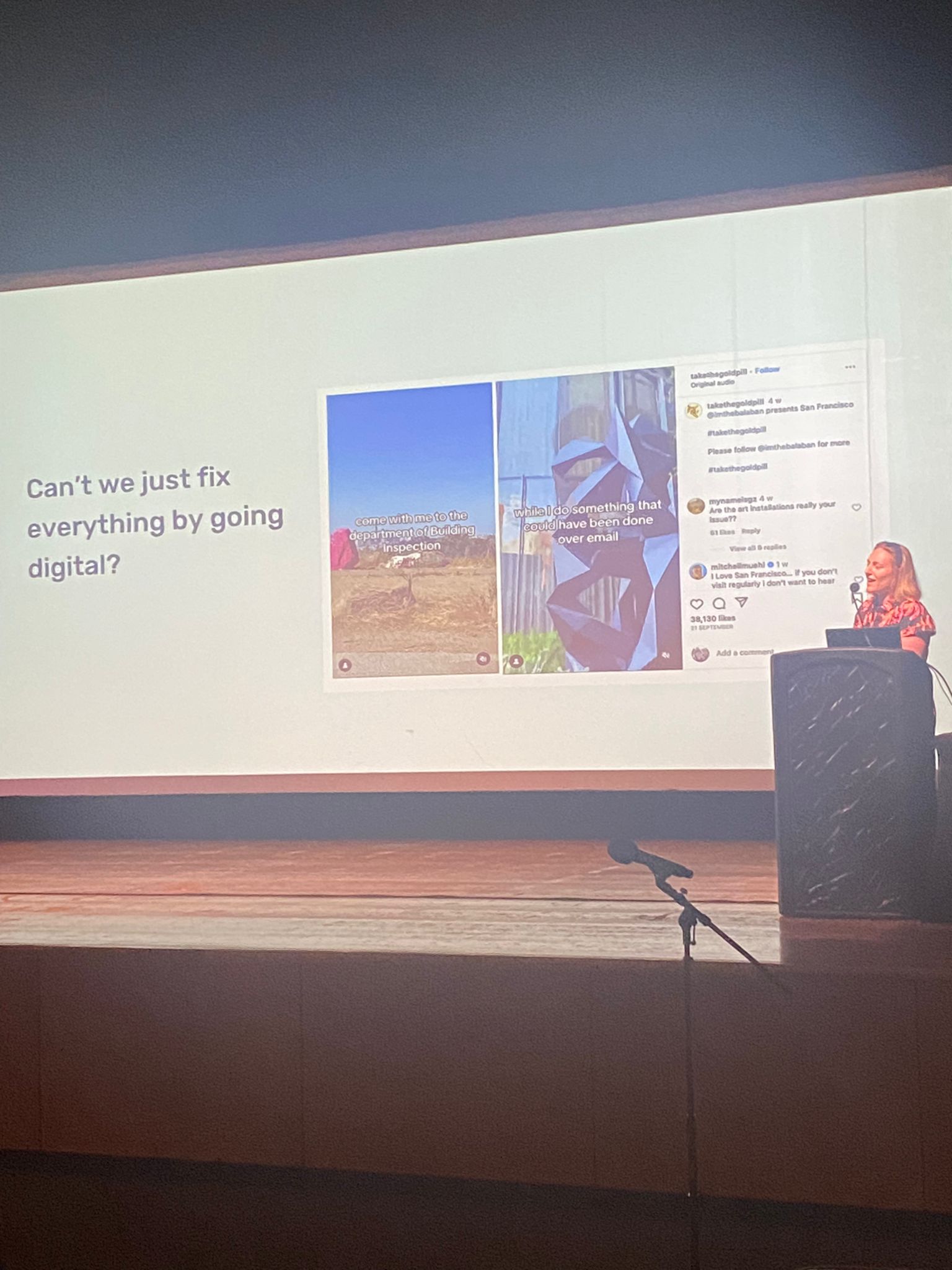
Case study - form needed to become legal street vendor in SF.
Came about through fall 2022 legislation that establish framework for licensing/regulation.
Dept came to Digital Services to develop the form.
Soon after launch, found that form were not being submitted by street vendors themselves, but instead by community orgs and citizens.
Why?
-
Low digital and government literacy made the form intimidating and challenging to fill out. But also reflects poor user experience design. For example, requirement to find your BAN number
-
Form’s structure made it difficult for street vendors to input information about their practices. are you stationary or moving? or ‘distance from cross street’ are not ways that they think about their practices.
-
low english literacy. But issue is that while forms are translated to different languages, first page of form says answers must be filled out in english.
Sources of friction: govt capacity and limitations around langauge. Only english-speaking staff, no budget for translaters, worries about liability if using automtic translations and gets it wrong.
misaligned mental models around location and hours - ie. intentionally put in open-ended and close-ended questions to help, but actually open-ended Qs caused stress and closed-ended Qs offered too limited/foreign choices.
Findings / takeaways:
-
Reducing some frictions (ie.. through digitization) creates other types of friction.
-
We cannot improve service delivery by solving the frictions faced by govt constituents alone. We must alsoo attend to the challenges experienced by and between govt staff.
A Personal Research Project that Turned into My Life’s Work (PechaKucha)
Shipra Kayan, none (Presenter)
project: remote work for refugees. research trip across 5 countries to find out why college-educated refugees not work remotely - happened on the eve of the pandemic.
wasn’t because of lack of internet access, language, skills etc.
Ended up starting a company powered by college-educated refugees.
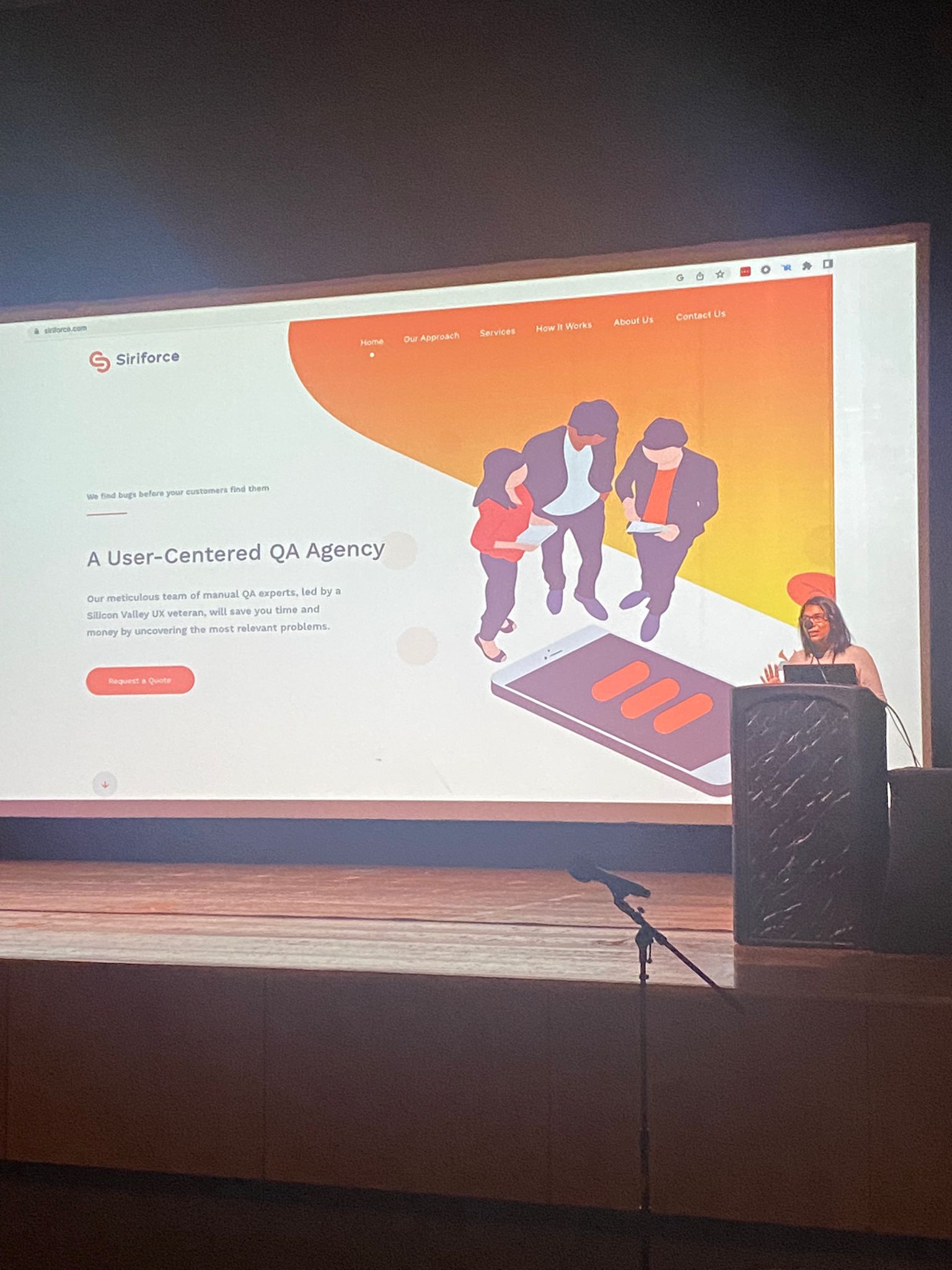
An unlikely band of software testers.
wer’e co-creating a different type of company. We shy away from efficieny to lean towards redundnacy so we could support each other.
We are now 3 years into this experiment. we’re profitable and sustainable.
insight wasn’t enough. i needed the wisdom that comes from experience. But who do I send the research report to? is it done now after 3 years or is it just beginning.
Adding Friction to Mandatory Reporting: The Case for Survivor-Centered Research (Paper)
Sarah Fathallah, Think of Us (Presenter) Anna Myers, Think of Us Verónica Rabelo, San Francisco State University
Mandatory reporting: legal requirement to file a govt report in cases of suspect abuse (of children, elderly etc)
this mandate can come from professional orgs, but also by law - any adult is a mandated reporter
mandated reporting comes with incentives - lack of reporting can be punished by penalites; reporting carries immunity, no burden of proof, etc.
Assumption is that reporting is good.
But… while mandatory reporting is highly incentivized, no evidence to show that it is beneficial.
imagined flow vs. what could actually happen:
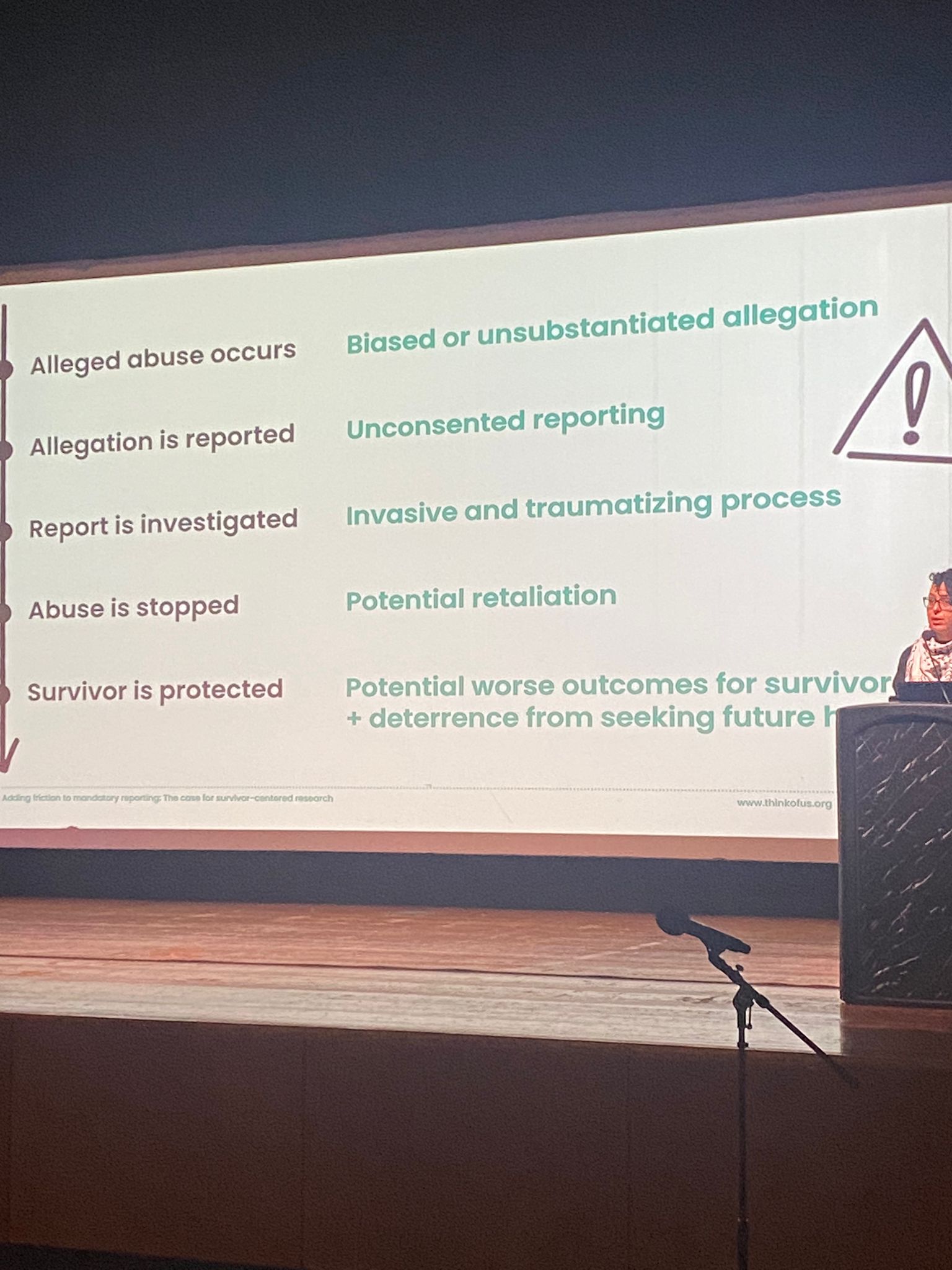
How might we improve mandatory reporting? adopt principles for survivor-centered approach:
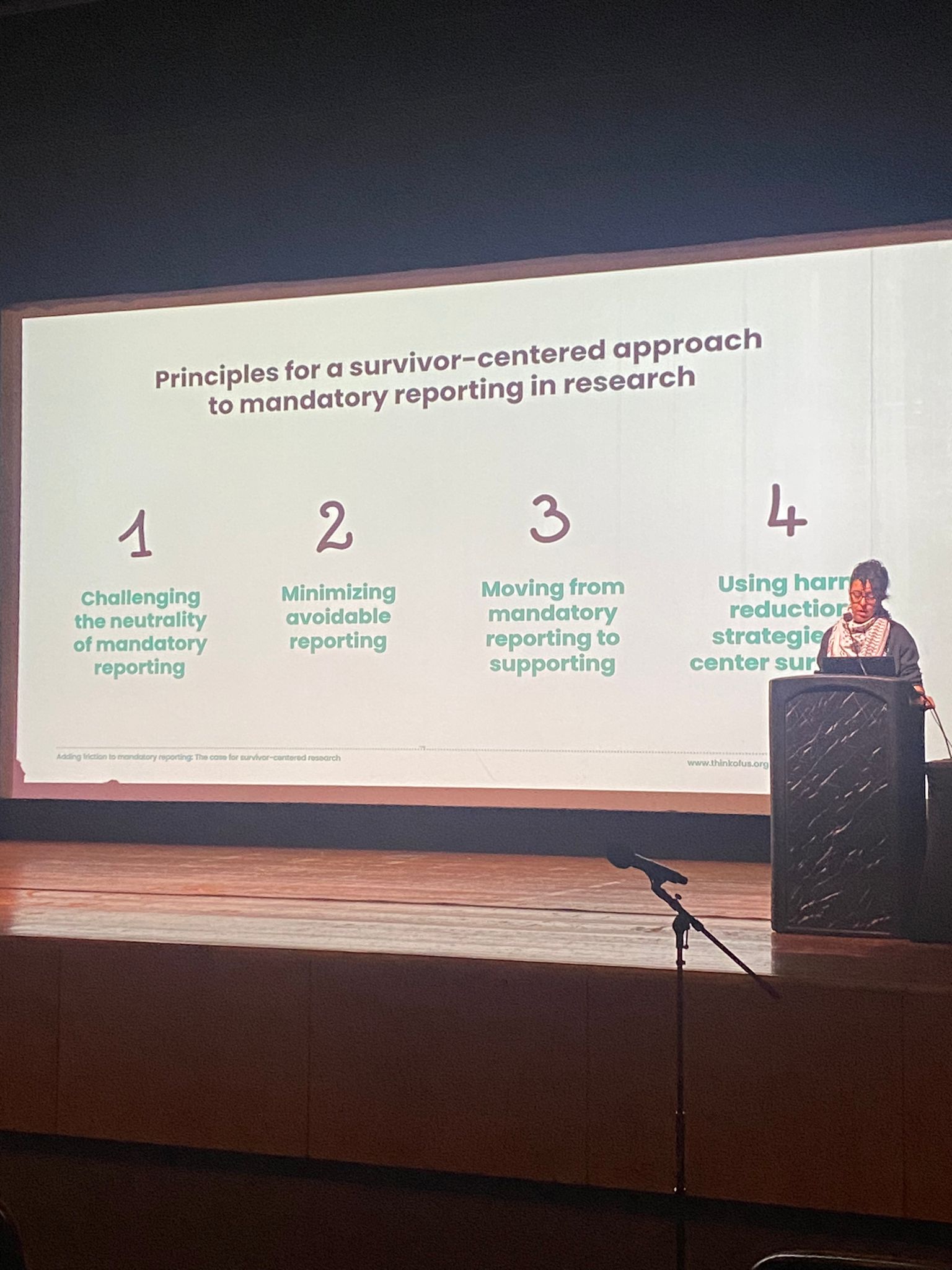
Identified three moments / touchpoints for when intervention and change could happen, and suggested a series of practical strategies to use in those moments.